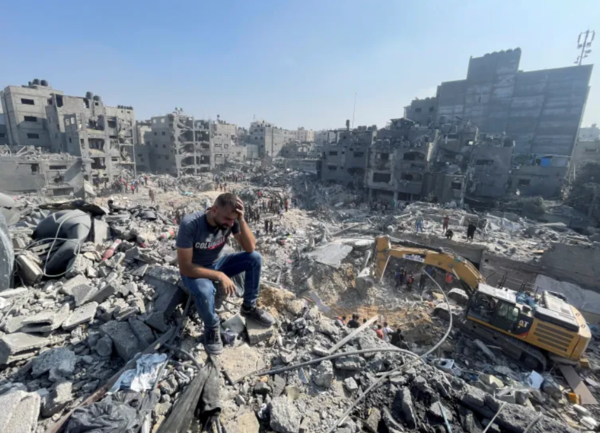The Israel-Palestinian war has been a hot topic in recent global discourse. The following Spotlight discusses the disproportionate impact on Palestinian civilians, and a historical overview tracing the conflict's roots from ancient times to the present.
The Gaza Strip, once again, finds itself in the throes of an escalating conflict that has surpassed political ideologies and militant agendas. In the most recent outbreak of violence, the region has witnessed a surge in civilian casualties, with more than 10,500 Palestinians and 1,200 Israelis reported dead as of November 9.
In recent years, Gaza has seen a series of violent flare-ups, including significant conflicts in 2006, 2008, 2012, 2014, and 2021. Each episode has compounded the enclave's humanitarian woes, with infrastructure decimated and basic services disrupted. The UN has repeatedly reported on the dire living conditions in Gaza, citing critical shortages in water, electricity, and medical care. The sirens and explosions are not random occurrences but part of a sequence that repeats itself with a weary predictability. Despite decades of conflict, there seems to be no military solution in sight. The bombardment of Gaza, often described as retaliatory, does little to advance the prospects of peace; instead, it lays the groundwork for the next chapter of hostility and despair.

Palestinians often find themselves disproportionately affected by the conflict, particularly in the stark number of civilian casualties. For instance, during the 2014 conflict, the United Nations estimated over 2,100 Palestinian deaths, of which a large proportion were civilians, in contrast to 73 Israeli deaths. Similarly, in the 2021 conflict, Palestinian fatalities were reported to be around 250, including many children and women, as opposed to 12 Israeli deaths. The presence of advanced missile defense systems like the Iron Dome starkly contrasts with the lack of shelters in Gaza. Each death, especially those of children who have no stake in political gambits, represents not just a loss for a family but an evisceration of the community's future.
The targeting of places traditionally seen as sanctuaries represents a collapse of the ethical framework that should govern armed conflict. In the recent conflict, several locations in Gaza that are typically seen as safe havens were attacked. This includes the al-Fakhoora school, a haven for displaced families, medical facilities such as the al-Quds Hospital, the Jabalia refugee camp, and various mosques and churches. The Geneva Conventions, designed to protect the innocent in times of war, seem a distant ideal when hospitals, mosques, churches, and schools are reduced to rubble. This pattern raises the uncomfortable question: is the value of Palestinian life considered differently within the strategic calculations of war?
The narrative of Hamas using human shields is a contested one, challenging the international community to disentangle truth from rhetoric. If civilians are indeed being used as shields, the tragedy is twofold: once for the coercion of the innocent and again for the lethal response it justifies. If not, then it's a tragic mischaracterization that serves to excuse the inexcusable. The onus is on global observers and participants to demand accountability and transparency, ensuring that the protection of civilians remains.
The military logic that drives Israel’s operations in Gaza often comes under scrutiny. The claim of defense through offense raises the critical question of whether such strategies truly make anyone safer or if they merely propagate a cycle of vengeance and retaliation. As of November 9, Israel has dropped a mind-numbing 25,000 tonnes of explosives on the Gaza Strip since October 7. To put this into perspective, the Little Boy nuclear bomb dropped on Hiroshima during World War II yielded 15,000 tonnes of high explosives and destroyed everything within a one-mile radius. When infrastructure is destroyed, civilians are killed, and children are orphaned, the seeds of hatred are sown, potentially breeding the next generation of "terrorist" fighters rather than fostering conditions for peace.
The international community often displays a double standard in its response to the Palestinian-Israeli conflict, with leaders like US President Joe Biden affirming Israel's right to self-defense, in stark contrast to their stance on similar conflicts, such as Ukraine. This inconsistency, highlighted by social media and commentators, is evident in the differing labels for resistance movements: Ukrainians are praised as 'freedom fighters', while Palestinians are often termed 'terrorists'. This disparity in reactions underscores the need for a universally applied human rights framework, one that holds all actors to the same account. This impartiality is essential, not only in the administration of justice but also in the provision of aid and the arbitration of peace.
The historical context of the Palestinian experience must not be ignored. It is a history fraught with the displacement of a people, mirrored in the experiences of indigenous populations worldwide who have faced the crushing machinery of colonialism. This shared narrative of losing ancestral lands to foreign domination, and the creation of narratives that justify such usurpation, is pivotal for a comprehensive understanding of the Palestinian plight. Recognizing this historical perspective not only humanizes their struggle but also underscores the need for a solution that acknowledges and addresses these deep-rooted injustices. This understanding is a prerequisite for any meaningful progress toward peace and reconciliation in the region.

